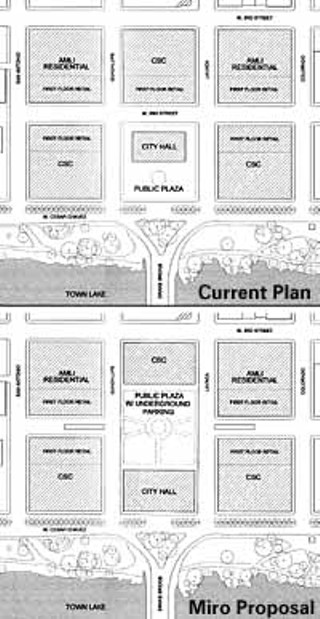Naked City
Architect Juan Miro proposes a new plan for the CSC-City Hall complex that's so simple and obvious, it's striking.
By Mike Clark-Madison, Fri., Sept. 8, 2000

Architect Juan Miro has presented a new plan for the downtown CSC-City Hall complex that would increase the size of the proposed City Hall, move it flush against Cesar Chavez, and relocate the public space : originally planned to face out onto Cesar Chavez : to an area between the trio of CSC buildings, City Hall, and two attached residential towers. Miro's plan could downsize the CSC building north of City Hall, if that space ever gets built, but would not affect the size of the two other CSC buildings that are currently under construction.
Jam Sessions
Considering the downtown-jammed state of the Warehouse District, isn't it too late to do anything about CSC? Well, almost. But if the city itself jams on it, we might yet turn the CSC/City Hall complex into a product of urban design, rather than of politico-industrial expediency.
That all is not well in CSC Land has become apparent. Because Computer Sciences Corporation wanted all its corner offices to have lake views, the city agreed to downsize its own City Hall, leaving superstar architect Antoine Predock to decorate the shoebox in which future mayors will be stored. The planned Second Street retail corridor through the heart of the district is proving difficult and expensive to realize. And it's hard to find any local design professional who doesn't say, "Well, it's not what I would have done, but ... "
So what could have been done in downtown's southwest quadrant? Well, anything, had the city not been gaga to hand over its most valuable real estate to a company who, three years into this gig, has yet to issue a press release announcing its plans to relocate its headquarters to Austin. But if we must have CSC, in the quantities and proportions specified by the etched-in-stone deal, we can still improve the public place.
One solution, so simple and obvious that it's striking, comes from architect Juan Miro, who advocates grouping the trio of CSC buildings, City Hall, and the two attached residential towers not along a Second Street "paseo," but around an actual one-block public plaza. Those with long memories are laughing right now, since the plaza-in-the-middle was a hallmark of the old Municipal Office Complex, which would have transformed this site in the 1980s had it ever been built.
As rendered by Sinclair Black and then re-rendered by Larry Speck (who, not incidentally, is the architect-of-record for CSC), the MOC plaza became a flashpoint for the project, and there's some connection between the MOC plaza and the CSC lack-of-same. There is in the CSC plan a half-block space on the lakefront side of City Hall (on what used to be the official City Council chambers parking lot). But it has yet to be well-explained how people would get to and use this space adjoining the four-lane highway that is West Cesar Chavez Street.
Miro's plans (there are several variations) would downsize the CSC building north of City Hall, but the software giant has many years to get around to building that space, if it ever needs it. So not much is being lost. (The two other CSC buildings, now under construction, would be unaffected.)
Likewise, Miro, like most architects with sense (including some on the Predock team), calls for City Hall -- which would be built flush against Cesar Chavez -- to be larger than CSC would allow. "They may lose some of their lake views, but those offices will now look out on a vibrant public space," Miro notes. "They'll find that those offices are the most popular."
Another bonus of Miro's plan is its sensible call to block off Second Street for good. Even if the current district layout stands, as long as Second Street remains a (secondary) commuter route out of downtown, the kind of retail you'll find there will be circumscribed. So we should be shutting it down anyway, and by the time downtown gets unjammed, people will likely have forgotten about it as an auto route.
While many (most?) Austin architects could have made the same proposal, it may have some added oomph coming from Miro -- a respected architect with an outsider's perspective. He's best known, probably, for designing Michael Dell's house; then New York-based, he ended up taking an apartment down here, decided he liked our town, and, since 1996, has called Austin home. With recent projects like the conversion of Cinema West for Future Protocol, Miro has enough buzz to be listened to without the baggage of an Austin lifer like Black or Speck.
But then again, Miro first presented his ideas to Mayor Kirk Watson two years ago and has yet to get any response. Now, with time a-wastin', he'd like to see his plan talked about. "I wouldn't gain from this at all," he says, "but this is an historic opportunity. Since being in Austin, I've felt strongly about lots of things that could happen here. Now I want to try to make them happen.
Got something to say on the subject? Send a letter to the editor.








